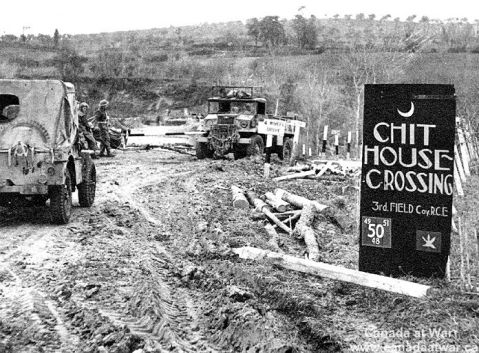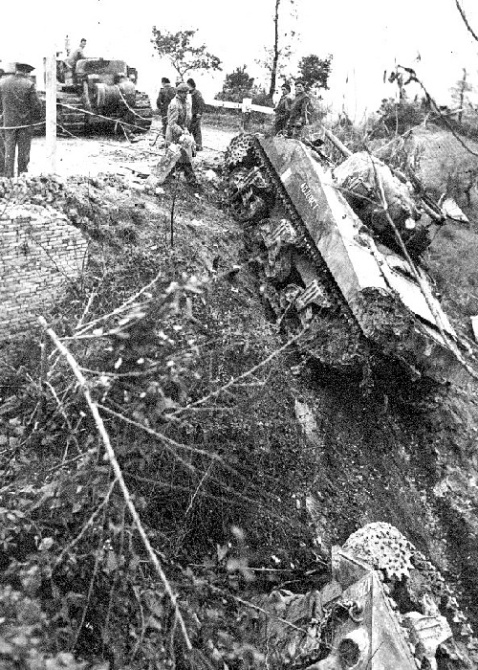Dec. 13, 1943


Universal carrier and mortar team of the Indian 6th Royal Frontier Force, between Lanciano and Osogna on the central sector of Eighth Army’s front, 13 December 1943.
NA 9785 IWM.
Left San Vito at 7:30 Bob Schoales, Ralph and driver and I in a light Field amb. Drove down over the familiar surroundings to the Sangro – where we found the engineers had replaced the blown bridge by a span 1,100 ft. long. The traffic was terrific, drove past all of our old camping grounds and finally arrived at Termoli at 3:30. From there we drove to Foggia, the last time I had seen this town was Oct. 1 – early in the morning in the Vanguard of the attack on Motta. We went from here to Barletta and then to Andria where the 1st Can Gen Hospital is. Was admitted and placed in public ward as all other wards are full.

Interrogation of a German soldier who entered San Leonardo di Ortona, Italy, in civilian clothes, 13 December 1943. Credit: Lieut. Frederick G. Whitcombe / Canada. Dept. of National Defence / Library and Archives Canada / PA-180098
Dec. 12, 1943

All packed up and ready to go to No. 1 Can Gen Hospital at Barletta tomorrow. Don’t know what my course will be from there, but probably Naples by rail. Looking forward to the trip. ADMS (assistant director medical services) visited again today.

Soldiers of the 1st Canadian Division carry a dead comrade killed by shell fire while escorting German prisoners. None of the prisoners was killed. 10 Dec 1943, San Leonardo di Ortona, Italy. Canada at War.
Meanwhile, the Moro River campaign continued. The following information is taken from Clearing The Gully: Army, Part 68 by Terry Copp on the Legion Magazine website:
Montgomery proposed to begin Operation Semblance on Dec. 15, but Allfrey and Major-General Chris Vokes–the Canadian divisional commander–wanted the Canadians to secure Cider Crossroads and the highway before joining in the promised corps advance. Vokes decided to commit his reserve, the 3rd Canadian Infantry Bde., to accomplish this. The West Nova Scotia Regt. made the first attempt at dusk on Dec. 11, but could make no progress. The next morning, the West Nova Scotia Regt. was ordered to try again, despite a driving rain. When this attack failed, Vokes employed all available three-inch and 4.2-inch mortars with their high-trajectory fire on the reverse slope, while the artillery suppressed other enemy positions. The Carleton and York Regt. led the new advance supported by flank attacks. After some early success, “murderous machine-gun and mortar fire” from within and beyond The Gully overwhelmed the battalion, which suffered 52 casualties as well as the loss of 28 men who were taken prisoner when a platoon was cut off.
Understanding the Italian Campaign (1943-1945)
A short and very sweet summary of the Italian Campaign from Library and Archives Canada blog. The story of the Italian Campaign is remarkable and complex and this post brings it all together nicely
Dec. 11, 1943: wounded and shelled, but sense of humour remains intact
House where I am is shelled, so they move downstairs – am visited by Col. Playfair ADMS – 1st Div. I am to be evacuated to Naples in a couple of days to 14 Gen. Hospital. Sent XIth and had Ralph brought in today. He is now looking after me. Even this place got shelled today – when the Old Folks Home gets shelled, it is time for me to move.

Artillery barrage at the Moro River Valley looking towards San Leonardo di Ortona. December, 1943
Italy. Virtual Museum.ca
Dec. 10, 1943: a shrapnel wound

We set out in our Jeep – Sgt. Hodgkins, on motorcycle and Slim and I in the jeep – the Padre (Smith) and Fred Ware in the jeep following us. We start down the face of the crest and are subjected to mortar fire. One mortar falls in the road about 40 feet ahead but causes no trouble. We proceed up the valley – cross the detour which the Engineers have constructed and ascend the escarpment towards San Leonardo – pull off the side of the road where two Calgary Tanks have been mined.
One Ontario Tank backs up, striking a mine and seriously wounded Slim, Sgt. Hodgkins and Fred Ware and one Ontario boy. We attend them, load them on the jeep ambulance and rush them back across the valley of the Moro to the Car Post, which I have established on top of the crest, by the rest of my section. Some German prisoners are wounded by one of their own shells and one of my boys Jack Carter goes to help him and is himself wounded.
I have been alone in regt. with only the Padre to help me. Jerry shells our line very heavily, hitting several PPCLI which we look after and evacuate. Then a most terrific barrage sets in – we jump into a ditch and I am wounded in the right ankle by shrapnel. I am able to carry on though for a while. Bruce Hunter and Bert Rutledge pull up and their RAP and we set up together.
In the evening we get called forward to San Leonardo to evacuate a wounded Seaforth. In this Town a few minutes before, the troops had been forced to evacuate due to heavy shell fire. It was perfectly quiet when we were in. On return to RAP my ankle is so painful I am forced to give in and the Padre drives me into M.D.S. #2, 2nd L.F.H. at Marino San Vito, where the tentative diagnosis is fractured Fibula and I am placed in a cast and put to bed.
- Burial service for a Canadian soldier killed by shell-fire, San Leonardo di Ortona, Italy, 10 December 1943. Credit: Lieut. Frederick G. Whitcombe / Canada. Dept. of National Defence / Library and Archives Canada / PA-129784
- Burial service for a Canadian soldier killed by shell-fire, San Leonardo di Ortona, Italy, 10 December 1943. Credit: Lieut. Frederick G. Whitcombe / Canada. Dept. of National Defence / Library and Archives Canada / PA-129784
- Major Roy C.H. Durnford, Chaplain of the Seaforth Highlanders of Canada, conducting a burial service, San Leonardo di Ortona, Italy, 10 December 1943. Credit: Lieut. Frederick G. Whitcombe / Canada. Dept. of National Defence / Library and Archives Canada / PA-167913
- Private G.C. Butcher, 48th Highlanders of Canada, examines the wreckage of a German PzKpfW III tank destroyed by the Calgary Regiment, San Leonardo di Ortona, Italy, 10 December 1943. Credit: Lieut. F.G. Whitcombe, Canada. Dept. of National Defence / Library and Archives Canada / PA-205251
- Privates J. Miller and W.H. Hall, both of The 48th Highlanders of Canada, digging a slit trench during a pause in a German counter-attack, San Leonardo di Ortona, Italy, 10 December 1943. Credit: Lieut. Frederick G. Whitcombe / Canada. Dept. of National Defence / Library and Archives Canada / PA-167658
- Captain F.M. Ritchie of The Calgary Regiment climbs out of his camouflaged Sherman tank, San Leonardo di Ortona, Italy, 10 December 1943. Credit: Lieut. Frederick G. Whitcombe / Canada. Dept. of National Defence / Library and Archives Canada / PA-167659
- A jeep ambulance of the Royal Canadian Army Medical Corps (R.C.A.M.C.) bringing in two wounded Canadian soldiers on the Moro River front south of San Leonardo di Ortona, Italy, 10 December 1943. Credit: Lieut. Frederick G. Whitcombe / Canada. Dept. of National Defence / Library and Archives Canada / PA-180097
Dec. 9, 1943: Moro River, German counter attack
Calgary’s “A” Squadron crossed the river and led the advance to San Leonardo. A few German prisoners straggling back. We prepare to advance at 1 p.m. – are just finishing dinner now before starting. We stand to all day and at night the Jerry makes a counter attack and crosses the river near the sea. We set up a R.A.P. (Regimental Aid Post) with PPCLI (Princess Patricia’s Canadian Light Infantry) – but nothing really happens. Our “C” Squadron has joined the Calgarys and in the night “A” Squadron cross the river and laagers down.

Infantrymen of The Seaforth Highlanders of Canada searching German prisoners on the Moro River front, Italy, 9 December 1943.
Canada at War.

During the fighting to gain San Leonardo Di Ortona, it was essential to put a bridge across the nearby Moro River. The Canadian Engineers constructed one overnight despite enemy shelling.
Canada at War.
Dec. 7, 1943: Moro River, “This is rather a hot spot.”

Dec. 7 – Some English tanks get across the Moro River and in to the Town of La Torre last night. We are standing to (6:30 a.m.) expecting to go up and cross the Moro R. at St. Leonardo. I have organized a fording party which I may have to use. The weather has cleared this morning. Moved at 11 a.m. – through San Vito, a very pretty drive. From the town we could see Ortona about ten kilos apart. Crossed the bridge of a tiny stream under shell fire. One shell landed in Calgary convoy behind us. We went into harbour on a ridge about two miles from the Moro River (A remarkable live broadcast with CBC Radio of the battle). Jerry opened up on us, wounding three and tearing a few holes in my jeep. This is rather a hot spot.

A Sherman tank from The British Columbia Dragoons crossing the Moro River, Italy, December 1943. Bernard Finestone. The Memory Project.
Dec. 6, 1943: Moro River
Finished second inoculation this a.m. We are on 1/2 hour notice – A and F 2nd Can Bde and 4th Armoured Bde attacking Ortonoa and bridge over Moro River. 14th being relieved by R.T.R. We go under command 1st Can. Div. – our roles is the spear head of the drive from the Ortona Road to the Pescara Rd. It seems to be settling down for a heavy rain, so this advance may become very difficult.
Dec. 4–5, 1943: Sangro River


The Sangro River November 1943: Sherman tanks of the 3rd County of London Yeomanry near Torino di Sangro prepare to move up to the River Sangro. In the foreground is a pile of 4.5 inch shells waiting to be used in the artillery barrage in support of the assault.
© IWM (NA 8906)
Dec. 4 – San Vito and Lanciano have both fallen – heavy artillery is pouring across the Sangro River in preparation for the attack on the line running from Ortona on the Adriatic to Guardiagrele. I expect after that is taken, we attack in the Chieti Pescara line – thus cutting the main lateral road to Rome.
Dec. 5 – The Sangro has flooded, washing all the bridges out – supplies are coming over in Ducks. The 14th are in action in front of Friso – helping to put the infantry over the Moro River. Inoculated “C” Squadron today. Move today at 1 p.m. – seven miles, which really took us ahead two and one half miles north. We are now about one mile north of Lanciano. Two air raids today. Fairly close, but no damage done. We have a good harbour in another olive grove and are very comfortable.

The Sangro River in Flood. Bailey Bridge Washed Away.
November 1943
(Imperial War Museum, London – source









